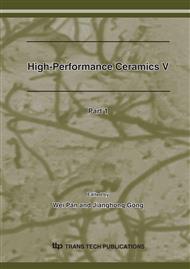p.659
p.663
p.666
p.669
p.672
p.675
p.679
p.683
p.686
Formation of Regular Hexagonal Dislocation Network in Chemical-Furnace Sintered Alumina
Abstract:
Polycrystalline alumina was prepared at high temperature and high pressure from combustion reaction plus mechanical pressure. The defect structure in the sintered alumina was investigated by transmission electron microscopy and a regular hexagonal dislocation network was found. Diffraction contrast technique revealed that the regular hexagonal network on the (0001) plane was composed of three dislocations with Burgers vectors: 1/3[1210], 1/3[ 2110] and 1/3[1120]. The formation process of dislocation network was discussed.
Info:
Periodical:
Pages:
672-674
Citation:
Online since:
February 2008
Authors:
Keywords:
Price:
Сopyright:
© 2008 Trans Tech Publications Ltd. All Rights Reserved
Share:
Citation:


